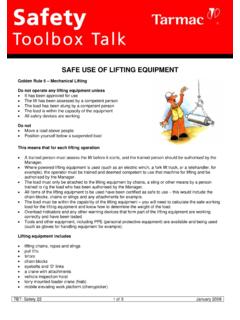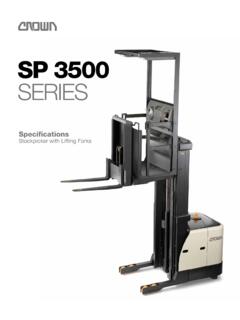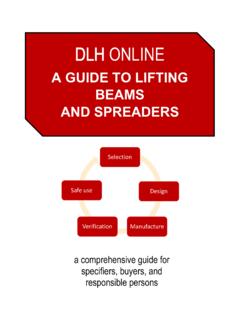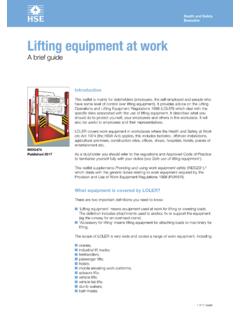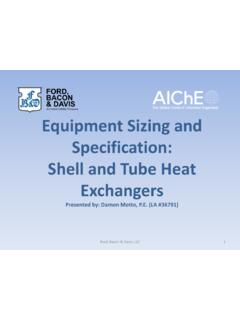Transcription of A GUIDE TO SHACKLES FOR LIFTING PURPOSES - Lifting …
1 Contact: Tel: 0845 270 2919 - INT: 00 44 161 223 1990 - Email: - Web: 1 A GUIDE TO SHACKLES FOR LIFTING PURPOSES BenefitsTypesManufacturersApplicationsSa fe use Contact: Tel: 0845 270 2919 - INT: 00 44 161 223 1990 - Email: - Web: 2 Table of contents Sections Title Page 1 Overview 3 2 Shackle Types 3 3 Standards 4 4 Certification 5 5 Markings and Working load limits 6 6 Body shapes 8 7 Pin types 9 8 Special purpose SHACKLES 10 9 Inspection 11 10 Storage and handling 11 11 Safe use 12 12 Manufacturers 13 13 More information and Contact Us 14 Web Navigation Note: Links highlighted in blue are hyperlinks to relevant products and guides on our website DLH ONLINE Contact: Tel: 0845 270 2919 - INT: 00 44 161 223 1990 - Email: - Web: 3 1. Overview SHACKLES have been widely used in the LIFTING industry for decades. However, despite (or perhaps because of) the apparent simplicity and extensive use of these components, incorrect and poor specification remains a problem.
2 Indeed it is one of the ironies of the LIFTING industry that it is not uncommon to see the safety of an operation involving thousands of pounds-worth of crane being compromised by an inappropriate shackle costing next to nothing in comparison. Although there has been development of high performance SHACKLES such as ROV for underwater off-shore use and Polar SHACKLES for extreme temperatures. Our aim with this GUIDE is to provide information on standard SHACKLES for general LIFTING applications 2. Shackle Types As far as SHACKLES are concerned, there are three main types for the buyer to choose from: Bow (or anchor) SHACKLES , Dee (or chain) SHACKLES and Grab SHACKLES with countersunk pin All comprise a U shaped body and a pin and they are sized by the diameter of the material in the body, not the pin which has a larger diameter (Not to be confused with Commercial mild steel SHACKLES , where the body and pin have the same diameter and are not certified for LIFTING PURPOSES ).
3 Back to Contents page Contact: Tel: 0845 270 2919 - INT: 00 44 161 223 1990 - Email: - Web: 4 3. Standards Normally forged from steel and, size for size, alloy steel SHACKLES have a higher safe working load (SWL) than those made in higher tensile steels. Mild steel SHACKLES are still manufactured for general engineering PURPOSES but there is no longer a standard for such SHACKLES for LIFTING PURPOSES . In theory, the metric British Standard BS 6994 (steel SHACKLES for LIFTING and general engineering PURPOSES Grade M (4)) should have been available since 1988. In practice very few SHACKLES have ever been made to this standard and its imperial predecessor, BS 3032 (higher tensile steel SHACKLES ) is still much more widely specified in the UK. Both standards have now been withdrawn by BSI although SHACKLES to BS 3032 are still manufactured and the only current British Standard is BS 3551 (alloy steel SHACKLES ).
4 US Federal Specifications, in the shape of RR-C-271, are increasingly popular and there is also a harmonised European Standard for grade 6 SHACKLES , prEN 13889, Crosby SHACKLES meet this standard. Crosby Screw Pin Bow (Anchor) Shackle Crosby Bolt and Nut Pin Bow (Anchor) Shackle Crosby Screw Pin Dee (Chain) Shackle Crosby Bolt and Nut Pin Dee (Chain) Shackle Whatever the individual preference, ensuring full compliance with the relevant standard should of course be a priority. The need to ensure full compliance with the relevant standard cannot be over-emphasised. Contact: Tel: 0845 270 2919 - INT: 00 44 161 223 1990 - Email: - Web: 5 Buyers should not only specify the size and type required, but also the standard number; they must then check that the product supplied is stated to be in full compliance. Phrases such as generally in compliance with are meaningless and should set the alarm bells ringing. Back to Contents page 4.
5 Certification As standard LIFTING SHACKLES supplied by us are accompanied with a report of thorough examination and or manufacturer declaration of conformity. Upon request at time of order, all load rated SHACKLES can be supplied with any of the following documents or certificates: - works certificate in accordance with EN 10204 - or ; - certificate of basic raw material in accordance with EN 10204 - ; - manufacturer test certificate; - EC Declaration of Conformity in accordance with annex IIA of the machine directive 98/37/EC; - inspection certificate in accordance with EN 10204 - or ; - proof load test certificate; - certificate with the actual breaking load experienced on tested samples; - test report of Magnetic Particle Inspection ( ); - test report of Ultrasonic Inspection ( ). Additional costs will be charged. The test certificates can be supplied surveyed by all official classification societies, such as Lloyd s, Det Norske Veritas, British Standards Bureau, American Bureau of Shipping, Germanischer Lloyd s or any other officially certified inspection body.
6 Back to Contents page Contact: Tel: 0845 270 2919 - INT: 00 44 161 223 1990 - Email: - Web: 6 5. Working load limits and markings SHACKLES certified for LIFTING PURPOSES are general stamped with the WLL, manufacturers mark and batch ID number. Crosby SHACKLES are embossed with the WLL, Crosby name and batch ID number. Additionally all Crosby SHACKLES , with the exception of 2160, 2169, 252 and 253 styles incorporate markings forged into the product that address an easy to use QUIC-CHECK feature. Crosby SHACKLES have angle indicators are forged into the shackle bow at 45 degree* angles from vertical. These are utilized on screw pin and bolt type SHACKLES to quickly check the approximate angle of a two-legged hitch, or quickly check the angle of a single leg hitch when the shackle pin is secured and the pull of the load is off vertical (side loaded), thus requiring a reduction in the working load limit of the shackle (See table 1).
7 Side loaded rating reduction table for 3/16 - 3 (120 metric tons) Table 1 Crosby Side Loading Reduction Chart for Screw Pin and Bolt Type SHACKLES Only+ Angle of Side Load from Vertical In-Line of Shackle Adjusted Working Load Limit 0 - 5 In-Line* 100% of Rated Working Load Limit 45 from In-Line* 70% of Rated Working Load Limit 90 from In-Line* 50% of Rated Working Load Limit + In-Line load is applied perpendicular to pin. * DO NOT SIDE LOAD SHACKLE PIN For SHACKLES larger than 125 metric tons, where the angle of the side load is greater than 5 degrees, contact Crosby Engineering. Contact: Tel: 0845 270 2919 - INT: 00 44 161 223 1990 - Email: - Web: 7 In terms of correct specification of SHACKLES , there are three main decisions to be made: the SWL, the shape, and the pin type. The working load limit must be at least equal to the total load imposed upon the shackle. If the load on the pin is distributed over its length, or part of its length, the load bearing capacity of the pin is effectively increased but that of the body is not.
8 It should be stressed that distributing the load right across the pin does not increase the strength of the shackle. Contact: Tel: 0845 270 2919 - INT: 00 44 161 223 1990 - Email: - Web: 8 6. Body shapes Large Bow (Anchor) shackle Large Dee (Chain) shackle Grab Shackle Selection of the right body shape depends on the intended use. It is desirable to use a shackle with as small a jaw opening as is consistent with adequate articulation of the connection. Buyers were able to select from large and small Dee and bow SHACKLES to BS3032 standard, obviously providing a choice in terms of the size of the internal clearances. However, following the introduction of prEN 13889, which offer higher loading in a smaller size, the small Dee and Bow BS3032 SHACKLES have become less cost effective and are now rarely available. Dee (chain) SHACKLES are generally used to join two pieces of LIFTING equipment , while bow (anchor) SHACKLES are typically employed where more than one attachment has to be made to the body.
9 For example if joining two single leg slings and connecting to the hook of a crane, or to allow freedom of movement in the plane of the bow. The necessity for the eye of a shackle to pass through another fitting may also have to be considered. Back to Contents page Contact: Tel: 0845 270 2919 - INT: 00 44 161 223 1990 - Email: - Web: 9 7. Pin types Screw Pin Bolt and Nut Pin For Dee and bow type SHACKLES there are essentially only two types of pin available: the screwed pin type and the nut and bolt type. The screwed pin is suitable for most PURPOSES provided there is little risk of the pin becoming unscrewed during the LIFTING operation. It has the advantage of keeping the shackle as a quick-to-assemble, two component item. The nut and bolt pin, together with a split retaining pin, is a four component item. The advantage of the latter, however, is that the pin cannot unscrew in service. It is therefore more suitable in applications where there may be movement which could cause the shackle to unscrew; where it remains connected for extensive periods; or in situations that do not allow the shackle to be seen easily and checked for security.
10 Back to Contents page Contact: Tel: 0845 270 2919 - INT: 00 44 161 223 1990 - Email: - Web: 10 8. Special purpose SHACKLES The grab shackle is effectively a Dee shackle with a screwed countersunk pin. As the name suggests, it is designed for use with grabs, where the shackle must pass through a circular aperture of minimum diameter. There is also available a Long Dee Piling Shackle with screw collar pin which meets the performance requirements of the withdrawn standard BS 3032. As with all LIFTING equipment , it is vital that the buyer tells the supplier about any particularly hazardous conditions or environmental issues that could compromise the long-term safety of the shackle. In particular, exposure to extreme temperature, chemical attack or other corrosive environments such as sea water should be mentioned. Corrosion resistant Stainless Steel LIFTING shackle to EN 10088 / (Marine Grade 316L) are available: Back to Contents page AISI 316 Stainless steel bow shackle bolt and nut pin AISI 316 Stainless steel Dee shackle bolt and nut pin AISI 316 Stainless steel Dee shackle screw pin Contact: Tel: 0845 270 2919 - INT: 00 44 161 223 1990 - Email: - Web: 11 9.
